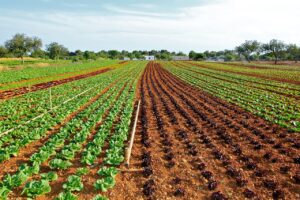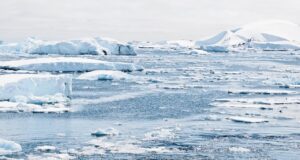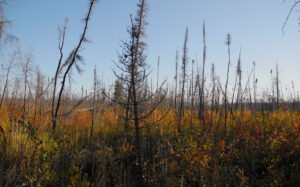On April 20, 2023, the U.S. Department of the Interior (DOI) and Department of Agriculture (USDA) released a first-of-its-kind inventory of the country’s mature and old-growth forests. The assessment responded directly to a 2022 executive order aimed at fostering healthy forests.
The inventory highlights the importance of forest health in building resilience to future climate-related disturbances like drought or fire, but it omits mention of the service that all forests, but particularly mature and old growth forests, provide in directly mitigating the country’s carbon emissions—a service that Woodwell Climate’s scientists have worked to measure and monitor for over three decades.
The inventory is a critical starting point, from which agencies like the U.S. Forest Service and the Bureau of Land Management will begin to make decisions about how public forests are managed going forward. Not acknowledging the critical carbon storage contribution of mature and old-growth forests runs the risk of de-prioritizing protection for the country’s oldest, most carbon-rich, and hardest to replace ecosystems.
Why protect mature and old-growth forests?
In short: carbon. While all forests sequester carbon as they grow, older and larger trees represent an existing store of carbon in their biomass and soil. Research by Woodwell Climate scientists on carbon stocks in a sample of federally managed U.S. forests found that while larger trees in mature stands constitute a small fraction of all trees, they store between 41 and 84 percent of the total carbon stock of all trees.
An analysis of mature and old growth forests across the country found that approximately 76 percent (20.8 million hectares) of these forests are unprotected from logging. This represents an amount of carbon roughly equivalent to 1 quarter of the US’s annual fossil fuel emissions.
Although younger forests grow faster proportionally, they are not adding as much carbon in a single year as older forests with large trees. Additionally, mature forests continue to pack away carbon year over year in their soils, which is largely protected from effects of disturbance. Cutting down a mature forest creates a “carbon debt” that can take decades—centuries in some cases—to recoup, and in the meantime those mature trees are no longer sequestering carbon each year.
“Forests are like naturally occurring factories, delivering to the planet the unique service of carbon sequestration. Trees of all sizes, but particularly large old trees, are the equivalent of warehouses where the goods produced—tons of carbon—are stored over time,” says Woodwell Climate Carbon Program Director, Dr. Wayne Walker. “Like any warehouse where valuable goods are stored, these natural carbon reserves deserve all the protection we can provide. Their loss could effectively bankrupt our efforts to avoid the worst impacts of climate change.”
Defining mature and old-growth forest
Protecting mature forests requires them to be identified and mapped, which was part of the impetus behind the government’s forest inventory. But what actually is a mature forest?
Definitions of “mature” and “old-growth” differ, with no one universally accepted definition. Refining scientific understanding of what constitutes a mature forest has implications for either expanding or reducing the area of forest considered for protection.
In one study of U.S. forest carbon stocks, Woodwell Climate researchers and collaborators outlined a measure of forest maturity based on both the age that the tree canopy in a forest becomes 100 percent closed, called “Culmination of Net Primary Productivity,” and tree diameter size. Across 11 U.S. forests analyzed, the age at which a forest is considered mature ranged from 35 years in Appalachian forests to 75 in Arizona. “Old-growth” represents a smaller subset of mature forests having older and larger trees.
The new inventory from the DOI and USDA uses a slightly narrower definition of maturity, wherein the lower bound occurs when regeneration has begun underneath the canopy. This results in a slightly smaller estimation of the amount of mature and old-growth forests in the US—yet still approximately 63 percent of the total area of federally managed forests.
Other definitions can be based on models that take into account measurements of forest structure like canopy height, canopy cover, and biomass. Another study, co-authored by Woodwell Climate Assistant Scientist, Dr. Brendan Rogers, used these features to determine that federal lands contain the largest concentration of the country’s mature and old growth forests.
Differences in those definitions are important, because forest policy debates surrounding the responsible management of these forests depend on adequately identifying them, particularly mature forests, which are much more loosely defined than old-growth.
“I think the discussion is almost more about what to do with mature forests, as opposed to old-growth,” says Woodwell Climate senior scientist, Dr. Richard Birdsey, who worked in the U.S. Forest Service for four decades. “Mature forests are at a younger stage of growth—trees would be smaller, although they could still be substantial in size and very profitable to harvest. So the question here is whether to let those forests grow into old-growth characteristics, or to start harvesting them for wood products.”
What do we do with our mature forests?
When climate benefits are explicitly considered, the research points strongly to letting these forests grow—protecting and expanding the massive portion of sequestered carbon they represent.
According to Dr. Birdsey, the largest threat facing mature and old-growth forests in the U.S. is logging, which is a threat that humans can reduce instantly, simply by changing policy. A change that would make those forests more resilient to other threats in the long run.
“Others might argue that climate change or wildfire are more significant threats,” says Dr. Birdsey. “Older forests with larger trees are more resistant to those threats—but not more resistant to chainsaws. That’s a human decision.”
A recent paper in Nature Climate Change has laid out a “protect, manage, restore” framework for making decisions about what natural climate solutions to pursue, and the highest priority is always to protect carbon where it is already stored. U.S. policies have made some recent progress in this direction through the enforcement of the roadless rule on Alaska’s Tongass National Forest, prohibiting road-building and industrial logging on the 9 million acre temperate rainforest. But there is still further to go to capitalize on the carbon storage potential of the U.S.’s mature forests.
Federally managed forests contain more high-carbon trees than other lands, so the opportunity for increased carbon storage within them is greatest. Woodwell Climate Distinguished Visiting Scientist, Dr. William Moomaw, helped coin the term “proforestation” to refer to the strategy of letting forests continue to grow as a carbon solution. In order to achieve that, he says, mature forests have to be protected.
“The next steps should be to provide legal protection of as much of these high-carbon forests as possible,” says Dr. Moomaw. “These are public lands that should serve the public good, and reducing climate change is a public good that we should pursue as the highest priority.”
Is this the end of lettuce? Why Canada’s food supply is headed for uncharted territory

Approximately three quarters of all produce consumed in Canada is imported, and California supplies a major chunk of that. So Canadians feel it when California is hammered by drought, flooding and other weather extremes.
Picture the Titanic, except filled with lettuce instead of passengers. Now picture five Titanics filled with lettuce, plus another half-filled ship. Picture this armada of ships, laden with romaine, spring mix, red leaf, green leaf, and iceberg, all setting sail for Canada.
This is how much lettuce our country imports every year: 265,000 metric tons in 2022 alone.
Read more on The Toronto Star.
‘Murderers’ and ‘criminals’: Meteorologists face unprecedented harassment from conspiracy theorists

“Murderers.” “Criminals.” “We are watching you.”
These are just a handful of the threats and abuse sent to meteorologists at AEMET, Spain’s national weather agency, in recent months. They come via social media, its website, letters, phone calls – even in the form of graffiti sprayed across one of its buildings.
Dr. Jennifer Francis – 2023’s symptoms of climate chaos, El Niño, ocean heatwaves, and Arctic sea ice lows

In this ClimateGenn episode I am speaking with Dr Jennifer Francis, a senior scientist at the Woods Hole Climate Research Center, in the US. 2023 has already seen record breaking temperatures in the atmosphere, land and oceans, with horrific impacts to human life, communities and ecology.
Here we focus on three factors in the climate system that drive these extremes and are still set to break more records, creating a great deal more destruction this year. We focus on the forming El Niño climate phenomenon, as well as ocean heatwaves, impacting the Atlantic and the North Pacific.
Transcript edited for grammar and clarity.
Sarah Ruiz: Fire. It’s a transformative force on any landscape, scorching and destroying, but often making space for new life. It also plays a part in transforming our global climate, releasing stored carbon from forests and other ecosystems that we simply cannot afford to add to our atmosphere. I’m here today with three of Woodwell Climate Research Center’s experts on fire and climate change: Dr. Manoela Machado, Dr. Brendan Rogers, and Dr. Zach Zobel. We’re here to discuss how fire fits into the climate change puzzle, as both a symptom and the cause of the warming climate. Consider this a “fireside chat” of sorts. Let’s begin.
Brendan, you work primarily in boreal forests, where fires are a natural part of the landscape, correct?
Dr. Brendan Rogers: Yes, that’s right. So even though boreal forests are in the north and they’re cold and damp for a lot of the year, the surface vegetation in the soil, the soil organic matter can dry out pretty dramatically in the summer. This fuel, as we call it in fire science, often all it takes is just one single ignition source to generate a pretty large wildfire. Humans certainly ignite fires, but still most of the burned area in boreal forests is coming from lightning ignitions.
Fire is also an important natural process in boreal forests. Many of the fires are what we call stand replacing—meaning they’re high intensity, they kill most of the trees, at least in Alaska and Canada. This initiates the process of forest succession, with often different types of vegetation, and tree species playing pretty key ecological roles. But fire regimes are changing and intensifying with climate change, taking us outside the range of what we would consider our natural variability that we’ve seen in these systems for millennia.
SR: Now, Manu, you work in the Amazon rainforest, where fire is never a natural part of the landscape. Can you explain what Kind of role fire plays in a tropical rainforest?
Dr. Manoela Machado: The Amazon biome did not evolve with fire pressure selecting for strategies of survival, which means that the plants are not adapted to this disturbance. Fire is a very powerful tool used to transform the landscape and has been used for millennia. Traditional and Indigenous communities still use it for agricultural purposes, but that’s not the fire that we see on the news, making headlines of “fire crisis in the Amazon.”
Those catastrophic events with lots of smoke in the atmosphere, they’re normally related to deforestation fires, which are fires used after clear cutting to clear out biomass and use the land for cattle ranching and other agricultural purposes. Those fires can escape into forest areas. So the ignition sources are always human—there are no natural ignition sources in the Amazon forest.
SR: With climate change, these dynamics are shifting in many places, as drier and hotter conditions make it easier for fires to spark. Zach, could you talk to us a little bit about what makes a forest susceptible to fire, and how climate change might be affecting that?
Dr. Zach Zobel: Fire weather is a given set of atmospheric parameters that indicate—if there was an ignition source—fire would be able to grow and spread rapidly. What we do is we model what is known as the fire weather index. This index consists of four different atmospheric variables, and those are: temperature (the hotter it is, the more likely vegetation is going to dry out quicker); relative humidity (the lower the humidity, the more rapidly vegetation can dry out); precipitation, both backward looking (“has it rained a lot recently”) and today; and wind speed, because once a fire starts, if the wind is adequately high, that’s when it’s going to spread.
We take those variables out of the climate models, and we model it—what it looks like historically, versus what it’s going to look like in the future. And what we find is that in several fire regimes, most of them actually, these “high fire risk days” are starting to rapidly increase.
We see it especially in the Mediterranean, Brazil, eastern Australia, the Western United States, in several parts of Africa. Over the next 30 years, we think these high fire risk days are going to increase on the order of a couple of weeks in some locations like the Western US, to upwards of one to two months in the Mediterranean and Brazil. And that’s pretty significant, when you think about how historically these days only occurred maybe one week a year.
SR: So what are some of the risk outcomes posed by those more frequent, intense fires, globally?
BR: More frequent intense fires are changing the ecology of many boreal forests in some cases, leading to transition from forest to grassland or shrubland, which of course impacts the resident animals. But there are also large impacts on humans. The smoke from large wildfire seasons is a direct threat to human health, and rural and especially Indigenous communities often feel the largest impacts. Additionally, in areas of permafrost, which is ground that is frozen year after year, fires can lead to permafrost thaw for many years. That can often destabilize the ground leading to ground collapse, presenting a hazard to people that are living in these areas.
MM: I think the Amazon has many similarities with the Arctic, despite being very different environments. Despite not being natural, fires have become a recurrent issue that coincides with the dry season, which then creates what we call the burning season. Any fire is damaging to an environment that is not adapted to it. So there’s the immediate release of huge amounts of carbon when that biomass is burning, and there’s the delayed mortality that understory fires cause, so there’s continued emissions of carbon as well. That can cause a shift in species composition.
And fire also begets fire, which means that forest canopy that is disrupted allows more wind and sun to penetrate the forest, which creates drier microclimates. And tree mortality increases the fuels on the forest floor as well. So a degraded forest becomes even more vulnerable to future burning. As Brendon mentioned as well, there are several studies linking the burning season with higher hospitalization rates of people with respiratory illnesses as well.
SR: So, then what do these changes mean in terms of fire risk? How much of what we’re seeing now is on par with or accelerated compared to what climate models have been showing?
ZZ: Manu, and Brendan just hit it right on the head. What we’re seeing is the driver of these increasing high fire risk days, is largely because the length of the dry season is increasing in many of these fire regimes. Since they talked about the tropics and the Arctic, I’ll use California as an example. The dry season is typically from April to November or December. What makes California almost even more unique is that if this extends later and later into November and December, that’s when the Santa Ana winds start to pick up. So we found that that’s what’s happening in California, the wildfire season is expanding into later in the season. And that’s when their seasonal winds start, ahead of the rainy season.
In terms of risk to life and property, there’s also another factor that I think is a little underappreciated. (and this is happening in the Mediterranean and Australia and some of the major spots I talked about, maybe less so in Brazil, but Chile as well) is people are moving into areas that traditionally have had wildfires, even in the absence of climate change. And so, as we continue to build up property, let’s say in California, in the wildland urban interface as it’s known, that’s when you start to see things unfold, like we saw in 2019, in Australia and the Camp Fire as well in California.
When we talk with our partners, we always show them how rapidly the climate models are viewing this increase in fire weather days. We definitely caveat it by saying, Here’s what the observations are showing us. The climate models aren’t even keeping up with how quickly wildfire risk days are increasing. So we view it as is “this is the best-case scenario for the next 30 years.” And the best-case scenario is scary enough. And that’s kind of the message we send to the people that we work with when presenting this data.
SR: Not only do increased fires have immediate ecological and safety impacts. They also represent a significant risk to our ability to achieve climate goals. Forests are one of our most valuable carbon sinks, and keeping them healthy and standing is essential to curbing warming. Let’s talk a little bit about how fires pose a threat to that.
BR: So boreal forest fires release some of the largest amounts of carbon per unit area for any biome on Earth. And this is because most of the fuel is coming from the soil organic matter or Duff. And most of the climate impacts are from CO2 and methane. But actually, there’s a whole host of gases that are released into the atmosphere. And what’s worse, in areas of permafrost, those fires can induce permafrost thaw and degradation that can also release even more greenhouse gases over the ensuing years. This is what triggers the global feedback mechanisms from boreal fires—climate warming, leading to more fires, which leads to more net emissions of greenhouse gases that further fuels climate warming.
When we combine the carbon release estimates from intensifying fire regimes with the interactions between fire and permafrost thaw, the numbers are somewhat sobering. And they may impact our ability to meet the global temperature targets such as one and a half and two degrees above pre-industrial as set out in the Paris Climate Agreement. These impacts are largely not accounted for in climate models or remaining carbon budgets. So, one big question is what can we actually do about it?
I first want to stress that the fires themselves are not the cause of the problem. They’re a system response to warming. So ultimately, the solution is reducing and eliminating fossil fuel emissions that are warming our climate. That said, we do actually have some level of control over boreal fires through fire management control that we don’t have, for example, when it comes to other bigger system feedbacks. Our group has done some work to show that boreal fire management and specifically suppression of fires when they’re first ignited and relatively small, could be a cost effective way to keep carbon in the ground and protect against rapid permafrost thaw. Actually recently, for the first time, a land management agency in the US has adopted these ideas and designated land in Alaska to be protected from fire purely for the purpose of protecting permafrost and carbon. Of course, there are many, many considerations that come into play with changing land management, for example, the ecological impacts, and of course, the people that live on or near that land, including indigenous communities. So these are really complex decisions. But ultimately, as we’re hopefully headed down a path towards global net zero emissions, towards climate stabilization and eventual climate cooling. I think that limiting boreal fire emissions should be considered as a natural climate solution that also has many co-benefits for the habitat, for human health, and the economy.
SR: So Manu, is fire management also a potential solution for the Amazon?
MM: Um, I don’t think it’s a solution, I think is something that exists, but also kind of in tune with what Brendan was saying that fire is not the core of the issue. In the Amazon, deforestation is the major issue regarding climate change in general. So, this process of land grabbing and clearing for cattle ranching and cropland is the driver of deforestation and for as long as we have that, we will have these catastrophic fire events. These deforestation fires and the leakage that comes from that into forest areas, those are not things that firefighters can face with safety. These are intentional fires, and they’re part of the deforestation process. So, the path to ending these fires is through tackling deforestation. The other types of fires such as pasture fires, forest fires that are not in those areas of like frontier of deforestation, they can be dealt with through prevention and combat actions, such as preparing firebreaks ahead of the expected burning season, and having well trained, well equipped brigades ready for action. And that’s something that we’ve been trying to do as well. We’ve been providing GIS training to Indigenous fire brigades across the Amazon and developed some other partnerships as well with spatial analysis and trying to help out with science too, but the core issue is not fire it’s deforestation.
SR: So, combating fires and learning to manage them when they arise is important, as well as working with communities on the ground to do so. But the root cause of climate change lies in the vast amount of carbon emissions that are released by human activities. Ultimately, bringing fires under control will require mitigating emissions and curbing climate change, otherwise, forest fires might just become too hot to handle. Thank you, everyone, for sharing your perspectives on fire and climate change with us today.
It’s already a large fire year in Canada: Weather watch

Fire season is underway in Canada. It tends to start early in Alberta and forests do burn, but the difference this year is one of scale: 2023 is an “already large fire year and it’s only mid-May,” said Brendan Rogers, an associate scientist who studies fires in Canada and Alaska’s boreal forests at the Woodwell Climate Research Center in Falmouth, Massachusetts.
Continue reading on BNN Bloomberg.



